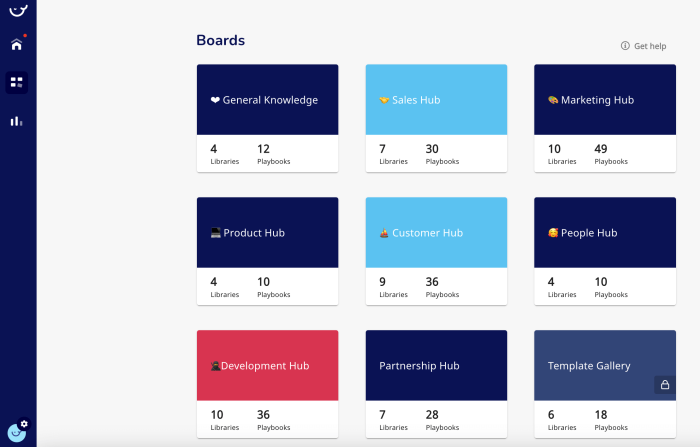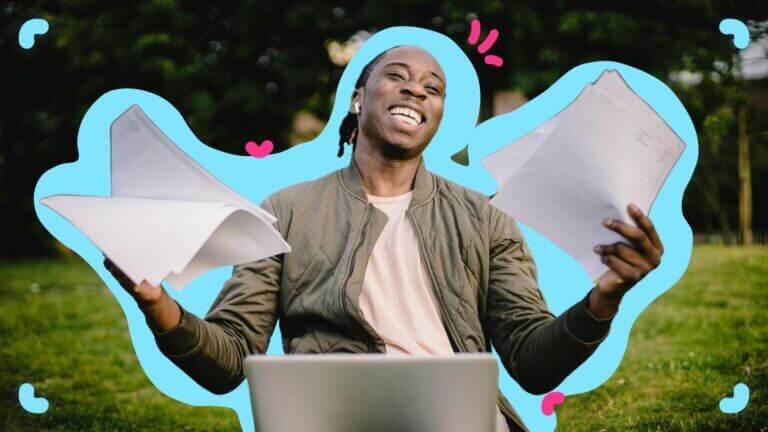Learning how to write Standard Operating Procedures (SOPs) can boost productivity, increase revenue, and maximize ROI – but only if you get it right.
Get it wrong and your employees will be frustrated, bored, and ready to move on — just like the 86% of employees looking for new jobs because of their company’s broken processes.
In this ultimate guide, we’ll give you the whats and whys of a great SOP, show you how to write Standard Operating Procedures that actually boost ROI.
Are you ready? Let’s go.
What is a SOP? 🤔
Standard Operating Procedures (SOPs) are the instructional playbooks that show employees exactly how to get work done. They unify operations, keep standards to a set quality, minimize training time, and ensure processes lead to the same output every time.
SOPs can be used in any department at any level, and generally have the same format (more on this in a minute). So, once you know how to write a Standard Operating Procedure that shines, you can do it again and again. 💪
The purpose of a SOP is ROI
The importance of SOPs in a business cannot be over-emphasized.
Benefits of having up-to-date, useable SOPs in your business include;
- Customer satisfaction
- Employee engagement and productivity
- Competitive advantage
- Knowledge-sharing
- Reduced burnout, and better work-life balance
Ultimately SOPs are a flywheel for growth and if done right, translate into ROI for a business.

Calculate your ROI
Whenever you’re choosing a new software solution for your team, you want to know what return you can expect.
How to write Standard Operating Procedures in 7 simple steps
- Step #1: Involve the right people
- Step #2: Choose your tool
- Step #3: Get the procedure documented
- Step #4: Name your SOP
- Step #5: Create a resources section
- Step #6: Focus on Useability
- Step #7: Improve and update your SOP
Ready to boost your ROI with Whale? Simply sign up free.
How to write SOPs that boost ROI?
We suggest that before you start writing your SOPs, you consider the initial and necessary steps prior to writing.
These include
- Identifying the processes that need to be documented. These are usually the 20% of processes that make 80% of the difference in a business. I.e. using the 80-20 rule.
- Identify the purpose of the SOP.
- Consider how you will be sharing the newly created SOPs and processes with your teams.
1. Involve the right people
To get your Standard Operating Procedure format right, you need to get the right people involved from day one. Remember, the more eyes you have on your SOP from the get-go, the more likely you are to smash it.
Here’s who to involve; (and they may be the same person depending on the size of your team).
- Departmental supervisors who manage the procedure outcomes.
- Employees who have worked on the procedure (or a similar one) before and know the fine details of how it should work and what would make it easier.
- Subject matter experts who can offer extra insights for a truly polished process.
So once you’ve gathered the right folks, set up a meeting and ask them to take you through the process step-by-step.
2. Choose the right tool
Boring docs that sit in Google Drive are old news — these days, you can make your SOPs truly shine with the right tool.
From automated updates to instructional videos, there are a million and one ways to make your SOPs easier (and more fun) to use.
Knowledge and training platforms are a great way to create, maintain, and share procedures across teams while keeping track of who sees what, and when.
Sounds awesome? That’s because it is.
3. Get the procedure documented
Writing killer Standard Operating Procedures doesn’t have to take time.
When it comes to writing SOPs employees love, we suggest using a tool. To truly live the SOP dream, knowledge and training platforms are the way to go. Using a digital platform allows you to create, manage, and share SOPs at the click of a button. Plus you can make them super visual for maximum employee engagement.
Here’s how to write your SOP;
- Use Whale’s AI assist to create a SOP from scratch in seconds
- Use a template to get you started
- Hire a Whale-certified partner to help you create the best documentation
- DIY, and yes, it can be easy to create the best documentation in-house, even if you’re starting from scratch.
4. Name your SOPs (And we don't mean Norman)
At Whale, we know what it takes to create the perfect SOP.
One small element that people often forget is the naming convention used. Naming your SOPs is crucial in order to eliminate confusion amongst team members.
Naming your SOPs properly will also ensure that they can be easily found when needed.
5. Add a resources section
Now you have the procedure down, it’s time to add the frills.
From the what-goes-where to any extra equipment, links, or handbooks, this step is all about giving employees what they need to actually get the work done.
Here’s what to include:
- The breakdown: Your instruction breakdowns are the extra need-to-know details for employees to get the job done, and can include just about anything. For example, if you’re onboarding a new hire, your SOP step might say, ‘Send policies to the new hire’, while your breakdown would define which policies (for example: Health and safety guidelines, Nondiscrimination policy, etc).
- The toolkit: Here’s where you list the equipment needed for each step, including anything from computer programs to physical tools. Let employees know where they can find it, how to access software, and give links to any existing resources (for example, a guide on how to set up and use your onboarding software).
- Health and safety: Some tasks have inherent health and safety issues. Include warnings, precautions, and links to health and safety policies here.
6. Focus on UX and useability
It’s all very well getting your SOP down on paper, but if it doesn’t look good or it’s not easy to follow, your employees probably won’t use it.
Here’s how to focus on user experience (UX) to ensure maximum SOP love:
- Keep it simple: Simplicity is king when it comes to SOPs employees actually want to use. Ask yourself, ‘Do I really need this word/sentence/step?’ If not, lose it.
- Drop the jargon: Some SOPs are so jargon-dense it’s hard to spot the instructions through the acronyms. Where possible, drop the unnecessary lingo and stick to simple wording.
- Make it visual: In a world of 24/7 TV, black-on-white Word docs no longer cut it. Use video, screenshots, memes, or gifs to bring your SOP firmly into the 21st century.
- Highlight important sections: Use fun visuals to highlight those can’t-miss sections. Think emojis, design elements, or borders.
7. Improve and update your SOP
Standard Operating Procedures are live documents you need to consistently keep an eye on.
As your business grows, your SOPs should be reviewed and become more streamlined – so make sure you’ve got a killer updating process in place to keep on top of changes and improve as you go.
Here’s how:
- Delegate SOPs (or sections of your SOP) to subject matter experts within your teams.
- Give them regular reminders to update their section.
- Updates should include dropping anything that saps time/resources and could be simplified.
- Share updates with the employees who use the SOPs

What should be included in your Standard Operating Procedure?
Here’s a brief outline of what to include in your SOP.
However, bear in mind that tailoring the document to the audience’s needs and understanding level is crucial for effectiveness. For instance, SOPs aimed at new employees may require more detailed explanations and background information compared to those designed for experienced staff.
Title Page
This should include the name of the procedure, SOP identification number, date of issuance or revision, the department or team it applies to, and the signatures or approval of those who prepared and approved the document.
Table of Contents
For longer SOPs, a table of contents is helpful for quick navigation.
Purpose
Clearly state the purpose of the SOP. This section should outline why the procedure is necessary and its scope, including what tasks or operations it covers.
Scope
Define the boundaries of the SOP, detailing where it applies, the extent of its application, and who should use it.
Definitions and Abbreviations
List and define all terms, acronyms, and abbreviations that may not be familiar to all readers.
Procedure
The core of the SOP. This section should be detailed and clearly outline the steps necessary to perform the procedure. It can be beneficial to structure this part with numbered steps, bullet points, and subsections for clarity.
- Introduction: Briefly describe the task and its importance.
- Preparation: List any prerequisites, including materials, equipment, safety gear, and any preliminary steps required before starting the main procedure.
- Procedure Steps: Detail each step in the order they should be performed. Use clear, direct language and avoid ambiguity. Visual aids such as flowcharts, diagrams, or photos can enhance understanding.
- Safety Considerations: Highlight any potential safety issues and how to mitigate them.
Responsibilities
Outline who is responsible for each part of the process. This clarifies roles and ensures accountability.
Quality Control and Compliance
Describe any measures for quality control and compliance with relevant standards or regulations. This may include checkpoints, audits, or documentation requirements.
References and Supporting Documents
List any external documents, guidelines, or standards that support the SOP. This can include legal regulations, industry standards, and best practices.
Revision History
Keep a log of all revisions to the document, including the date, the nature of the change, and who approved it.
What is the problem with bad SOPs?
It’s often a challenge to get SOPs documented.
The problem is, SOPs are notoriously dense, jargon-packed, and hard to follow, making it a struggle for employees to finish tasks, and leaving companies out of pocket thanks to lost productivity.
But there is another way.
With the right tools and a quality SOP writing process, you can leap ahead of the competition to boost ROI and watch your revenue skyrocket. 🚀
Your SOP Writing Checklist
When writing your SOPs remember to;
- ✅ Make it easy to understand
- ✅ Use a consistent style
- ✅ Make it visually appealing
- ✅ Answer the question who does what and how?
- ✅ Share it with the right people
Bottom line?
Gone are the days of SOP paperwork pile-ups. These days, digital is the new king. Platforms and technology tools are designed to help you scale.
Use a knowledge-sharing and training platform to breathe fresh life into outdated documentation; you’re guaranteed to boost productivity, improve ROI, and watch your revenue skyrocket.
From easy-to-use dashboards to those visual extras, there are a ton of ways the right tool can help uplevel your SOPs so employees can dig deeper. With the right tools, the possibilities are endless.
Want to scale your business with killer SOPs employees actually love?
Download our complimentary Ultimate Guide to SOP and Process Documentation below.
FAQs on how write Standard Operating Procedures
What is the best format for a SOP?
The very format for your Standard Operating Procedures is the one that your team will use.
It’s no good spending time creating a document that no one reads.
The simpler and easier to understand, the better.
Here are some examples of formats that you may choose to use;
- Flowcharts
- Checklists
- Videos
- Interactive courses
- Step-by-step written format
- Infographics
How to write a SOP Example?
Thankfully, unlike "the olden days" you don’t have to spend weeks creating a SOP.
You can get it done in seconds!
There are a few options;
- Use a SOP Template to get started
- Use AI to Assist you to create in seconds
- Get a consultant on board to help you – it may take a little longer but it’ll be right!
Here are 3 SOP examples your employees will love.
How many SOPs or processes does a company need?
The idea isn’t to have a million documents. It’s important to use the 80-20 rule regarding documentation. Create and use the 20% of SOPs that contribute to 80% of your business results.
Ultimate Guide to SOP & Process Documentation
The why, what, and how to unlock the next level of growth in your business with SOPS & systems








